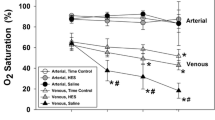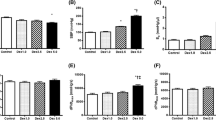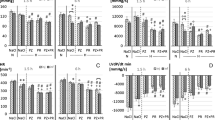Summary
The effect of myocardial depression on the circulatory response to acute normovolemic hemodilution (hematocrit 23%) with hetastarch was evaluated in 28 anesthetized Sprague-Dawley rats. Cardiac output was recorded using an electromagnetic flow probe. Mild, moderate, and severe myocardial depression were achieved by infusing disopyramide 50, 75, and 85 mg/kg. This resulted in a dose-dependent decrease in cardiac output (r=−0.73, p<0.05) and mean arterial pressure (r=−0.65, p<0.05), and an increase in left ventricular end-diastolic pressure (r=0.77, p<0.05) and total peripheral resistance (r=0.46, p<0.05). Following hemodilution, cardiac output and mean arterial pressure were significantly lower and total peripheral resistance significantly higher in animals with myocardial depression compared with saline anemic controls. These differences were dose-dependent for cardiac output (r=−0.83, p<0.05), mean arterial pressure (r=−0.68, p<0.05), and total peripheral resistance (r=0.51, p<0.05). Although control animals were able to significantly increase their cardiac output and stroke volume after hemodilution compared with baseline, animals with severe myocardial depression were unable to do so. This resulted in marked hypotension after hemodilution in controls compared with severely depressed animals. The results suggest a diminished ability of the pharmacologically depressed heart to tolerate acute normovolemic hemodilution.
Similar content being viewed by others
References
Bonde J, Pedersen LE, Anselo HR, Trap-Jensen J, Svendsen TL, Kampmann JP (1987) Haemodynamic effects of disopyramide using a new model of intravenous infusion. Pharm Toxicol 60:179–183
Brogden RN, Todd PA (1987) Disopyramide. A reappraisal of its pharmacodynamic and pharmacokinetie properties, and therapeutic use in cardiac arrhythmias. Drugs 34:151–187
Chapler CK, Hatcher JD, Jennings DB, (1972) Cardiovascular effects of propranolol during acute experimental anemia in dogs. Can J Physiol Pharmacol 50:1052–1060
Cosgrove DM, Thurer RL, Lytle BW, Gill CG, Peter M, Loop FD (1979) Blood conservation during myocardial revascularization. Ann Thorac Surg 28:184–189
Crystal GJ, Ruiz JR, Rooncy MW, Salem MR (1988) Regional hemodynamics and oxygen supply during isovolemic hemodilution in the absence and presence of high-grade beta-adrenergic blockade. J Cardiothor Anesth 2:772–779
Elb S, Arturson G (1969) Comparison of physical work capacity in rats following severe haemodilution with colloid and crystalloid solutions. Acta Anesth Scand 13:103–111
Elliott HL, Thompson AH, Bryson SM (1986) Disopyramide in acute myocardial infarction: Problems with changing pharmacokinetics. Eur J Clin Pharmacol 30:345–347
Elzinga G, Westerhof N (1979) How to quantify pump function of the heart. Circ Res 44:303–308
Escobar E, Jones NL, Rapaport E, Murray JF (1966) Ventricular performance in acute normovolemic anemia and effects of beta-blockade. Am J Physiol 211:877–884
Estafanous FG, Sheng Z, Pedrinelli R, Azmy SS, Tarazi RC (1987) Hemodilution affects the pressor response to norepinephrine. J Cardiothoracic Anesth 1:36–41
Fowler NO, Homes JC (1975) Blood viscosity and cardiac output in acute experimental anemia. J Appl Physiol 39:453–456
Glick A, Plauth WH, Braunwald E (1964) Role of the autonomic nervous system in the circulatory response to acutely induced anemia in unanesthetized dogs. J Clin Invest 43:2112–2124
Gottdiener JS, DiBianco R, Bates R, Sauerbrunn BJ, Fletcher RD (1983) Effects of disopyramide on left ventricular function: Assessment by radionuclide cineangiography. Am J Cardiol 51:1554–1558
Green AC, Iskandrian AS, Hakki AH, Kane SA, Segal BL (1983) Effect of oral disopyramide therapy on left ventricular function. Chest 83:480–484
Guyton AC, Richardson TQ (1961) Effect of hematocrit on venous return. Circ Res 9:157–164
Hulting J, Jansson B (1977) Antiarrhythmic and electrocardiographic effects of single oral doses of disopyramide. Eur J Clin Pharmacol 11:91–99
Jensen G, Sigurd B, Uhrenholt A (1975) Haemodynamic effects of intravenous disopyramide in heart failure. Eur J Clin Pharmacol 8:167–173
Josephson ME, Caracta AR, Lau SH et al (1973) Electrophysiologic evaluation of disopyramide in man. Am Heart J 86:771–780
Kessler M, Messmer K (1975) Tissue oxygenation during hemodilution. In: Messmer K, Schmid-Schonbein H (eds) Intentional Hemodilution. Bibliotheca Hacmatologica, 41:16–23, Karger, Basel
Kotter V, Linderer T, Schroder R (1980) Effects of disopyramide on systemic and coronary hemodynamics and myocardial metabolism in patients with coronary artery disease: Comparison with lidocaine. Am J Cardiol 46:469–475
Kramer AH, Hertzer NR, Beven EG (1979) Intraoperative hemodilution during elective vascular reconstruction. Surg Gynecol Obstet 149:831–836
Leach AJ, Brown JE, Armstrong PW (1980) Cardiac depression by intravenous disopyramide in patients with left ventricular dysfunction. Am J Med 68:839–844
Mathur PP (1972) Cardiovascular effects of a newer antiarrhythmic agent, disopyramide phosphate. Am Heart J 84:764–70
Messmer K, Kreimeir U, Intaglietta M (1986) Present state of intentional hemodilution. Eur Surg Res 18:245–263
Messmer K (1975) Hemodilution. Surg Clin N Amer 55:659–678
Messmer K, Sunder-Plassman L, Klovekorn WP, Holper K (1972) Circulatory significance of hemodilution: Rheologic changes and limitations. Adv Microcirc 4:1–77
Nakasato SK (1982) Evaluation of hetastarch. Clin Pharm 1:509–514
Podrid PJ, Schoeneberger A, Lown B (1980) Congestive heart failure caused by oral disopyramide. N Engl J Med 302:614–617
Replogle R, Merrill EW (1970) Experimental polycythemia and hemodilution: Physiologic and rheologic effects. J Thorac Cardiovasc Surg 60:582–588
Ribeiro C, Longo A (1987) Procainamide and disopyramide. Eur Heart J 8(suppl A):11–19
Rizos I, Brachmann J, Lengfelder W, Schmitt C, Olshausen KV, Kubler W, Senges J (1987) Effects of intravenous disopyramide and quinidine on normal myocardium and on the characteristics of arrhythmias. Eur Heart J 8:154–163
Ross D, Vohra J, Sloman JG (1978) Disopyramide in myocardial infarction (letter). Lancet 2:330
Rousson D, Piolat C, Galleyrand J, Ferry S, Boissel JP (1986) Systolic time intervals in evaluation of the negative inotropic effect after single oral doses of mexiletine and disopyramide. Eur J Clin Pharmacol 30:263–268
Siddoway LA, Woosley PL (1986) Clinical pharmacokinetics of disopyramide. Clin Pharmacokinet 11:214–222
Story JR, Abdulla AM, Frank MJ (1979) Cardiogenic shock and disopyramide phosphate. JAMA 242:654–655
Takaori M, Safar P, Galla SJ (1968) Comparison of hydroxyethyl starch with plasma and dextrans in severe haemodilution. Can Anaesth Soc J 15:347–356
Utley JR, Moores WY, Stephens DB (1981) Blood conservation techniques. Ann Thorac Surg 31:482–490
Van Gitters RL, Franklin DL, Rushmer RF (1964) Left ventricular dynamics in dogs during anesthesia with alpha-chloralose and sodium pentobarbital. Am J Cardiol 13:349–354
Walsh RA, Horwitz LD (1979) Adverse hemodynamic effects of intravenous disopyramide compared with quinidine in conscious dogs. Circulation 60:1053–1058
Willis PW (1975) The hemodynamic effects of Norpace II. Angiology 26:106–112
Winslow E, Marshall RJ, Campbell JK et al (1987) Effects of diet-induced hypokalemia on the efficacy of antiarrhythmic drugs against ventricular arrhythmias evoked by coronary artery ligation in the anaesthetied rat. J Cardiovasc Pharmacol 9:257–266
Author information
Authors and Affiliations
Rights and permissions
About this article
Cite this article
Estafanous, F.G., Smith, C.E., Selim, W.M. et al. Cardiovascular effects of acute normovolemic hemodilution in rats with disopyramide-induced myocardial depression. Basic Res Cardiol 85, 227–236 (1990). https://doi.org/10.1007/BF01907111
Received:
Issue Date:
DOI: https://doi.org/10.1007/BF01907111




